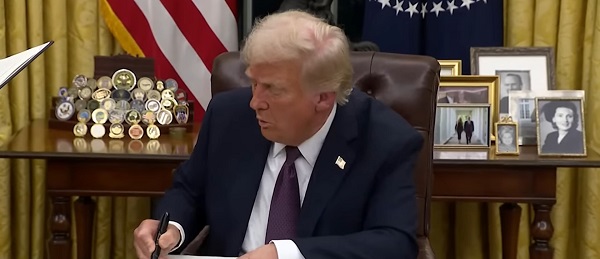Brownstone Institute
Flagellantism Is the New Political Ritual

From the Brownstone Institute
BY
The old FedEx envelope was clever, a work of art even, optimistic and colorful, signifying speed and progress. What a beautiful contrast to the plainness of the US Postal Service. For years, I can recall dropping off these treasures and paying maybe $10 to assure its delivery across the country, even the world. For me, it was a fabulous symbol of an improved life, living proof that progress was baked into the historical trajectory.
But two days ago, the clerk at the FedEx office confirmed a different ethos. There was no doing business without a scan of my government-issued ID. I asked for confirmation: so if I did not have this, there is simply no way that I can send a package. Confirmed.
Then came the envelope. It was the color of the brown bag I took to school when I was a kid. Serviceable, drab, dull. Also the new one is stamped with a big green marker: recyclable. There is no design, no art, certainly no beauty. It’s all gone. Its main message is suffering.
What happened to the old envelopes? They’ve been replaced, the clerk explained firmly, with no more detail.
A recycle exhortation suggests shortage. We have to reuse everything because there just isn’t enough to go around. We must sacrifice. The color suggests privation. It’s an aesthetic of sadness and penance. Then of course the price tag came: $26 for delivery not tomorrow but in two days. So compared with some years ago, we pay 2.5 times as much for service half as good as it was.
Don’t complain. It’s just the new way. It’s the new way of life.
What happened to progress? It’s been replaced. The new path is flagellantism: in politics, culture, economics, and everywhere.
The flagellants were a medieval movement of public penitents that roamed from town to town in garbs of woe, flogging themselves and begging as penance for pestilence and war. They were infused with a fiery, apocalyptic, and millenarian passion that they could see terrible moral realities to which others were blinded. The theory was that plagues were being visited upon the earth by God as punishment for sin. The answer was contribution, sorrow, and acts of penance as a means of appeasement, in order to make the bad times go away.
It’s true that there were people who did so in private but that was not the main point. The central focus and purpose of the flagellant movement was to make one’s suffering public and conspicuous, an early version of the virtue signal. In the guise of personal sorrow, they were really about spreading guilt to others. They would show up at any public celebration with a message: your happiness is causing our suffering. The more you party, the more we are forced to bear the burden of the need to be in pain for your sins. Your joy is prolonging the suffering of the world.
Flagellantry is most recognizable in the aesthetic. The first signs I recall seeing of this occurred immediately during the panic of March 2020 when it was proclaimed from on high that a terrible virus was visiting the US. No, you couldn’t see it, but it is highly dangerous, everywhere present, and should be avoided at all costs. You must wash constantly, douse yourself with sanitizer, cover your face, dress in drab colors, and be sad as much as possible.
Fun things were banned: public gatherings, singing, house parties, weddings, and all celebrations. This whole scene took on a political patina, as people were invited to think of the invisible virus as a symbol of a more tangible virus in the White House, an evil man who had invaded a holy space whose malice had leaked out in the culture and now threatened to poison everything. The more you complied with mandatory misery, the more your work made a contribution to making the pestilence go away while we wait for the inoculation. That could take two forms: driving him from the White House or releasing the vaccine which everyone would accept.
Joseph Campbell was correct about the role of religious impulses in the human mind. They never go away. They just take on different forms according to the style of the times. Every single feature of traditional religion found a new expression in the Covid religion. We had masking rituals that were rather complicated but learned and practiced quickly by multitudes: mask on while standing and mask off when sitting. We had sacramentals like social distancing and communion with vaccination. Our holy water became sanitizer and our prophets on earth were government bureaucrats like Fauci.
Flagellantism did not disappear once the old president left and the new one came. Even after the pandemic ended, there were new signs that God was angry. There was the ever-present climate change which was a sign of earth’s anger for being drilled and carved up for energy sources. And the bad country said to be responsible for the unwelcome invader of the White House – Russia – was now rampaging through the holy land of its neighbors.
In addition, the broader problem was capitalism itself, which gave us things like meat, gasoline, fur, and other signs of evil. And what gave rise to capitalism? The answer should be obvious: imperialism, colonialism, racism, and the existence of whiteness – each of which called for mass penance.
The pandemic unleashed it all. It was during this period that corporations decided that profitability alone required signs of suffering and hence the rise of ESG and DEI as new ways to assess economic value of corporate culture. And new practices were added to the list of the highly suspect: monogamy, heterosexuality, and religious traditions such as Christianity and Orthodox Judaism that should now be regarded as deprecated, even as part of the underlying problem.
It was during this period when I found myself on an apartment hunt and observed a newly remodeled offering. I asked why the owner had not replaced the flooring. I was corrected: these are new floors. Impossible, I thought. They are gray and ghastly. That’s the new fashion, I was told. Looking it up, it was true. Gray flooring was being installed everywhere.
How does wood become gray? It dies. It starts to decay. It is swept away by rivers and floats around for years, alternatively soaked, baked by the sun, and soaked again, until every bit of color is drained away. It becomes driftwood, a survivor of the elements and a symbol of the brutality of the cycle of life. Gray flooring is therefore the ideal symbol of the age of suffering, the proper material on which to move back and forth pondering the evils of the world.
In a world governed by flagellantism, ugly formlessness rises to replace aspirational art and imaginative creativity. This is why public art is so depressing and why even the clothing we can afford at the store all looks dreary and uniform. In this world, too, gender differences disappear as luxurious signs of decadence we can no longer afford.
Two other anecdotes. The overhead bins on the flight just now were largely empty, simply because most passengers chose the cheaper Basic Economy fare. This also requires they have no carry-on luggage and hence be forced to pay for checked luggage or travel with all their belongings in a backpack. We’ve gone from gigantic Louis Vuitton steamer trunks to stuffing things in pockets and hiding them from authorities.
Another case in point. I asked the man in the high-end shoe shop why none of the shoes had leather soles. Instead all shoes have these cushy rubber soles that seem weak and pathetic, and make no noise when one steps.
“Everything has changed since covid,” he said. “All shoes are house shoes now.”
I had no words and walked away, my entire thesis confirmed.
Sure enough, all the data we have suggests the mighty triumph of flagellantism. Fertility is down dramatically. Life spans are shortening. People are sicker. Excess deaths are rising. We learn less, read less, write less, create less, love less. Personal trauma is everywhere. The groceries are more expensive so we eat whatever we can, when we can, while hoping for breezes and whatever sunlight there is to provide just the essential energy we need to slog through another day.
Degrowth is the economic model of flagellantism, reducing consumption, embracing privation, acquiescing to austerity. We no longer declare recessions to be on their way because recession is the new way we live, the realization of the plan. The word recession implies a future of recovery, and that is not in the cards.
Decolonization is another watchword. It means feeling so guilty about the space you inhabit that your only moral action is to stay put and reflect on the sufferings of those you have displaced. You can of course say a prayer of supplication to them, so long as you never appropriate any aspect of their culture, since doing so would seem to affirm your rights as a human being.
You want joy, beauty, color, drama, adventure, and love? It’s not gone entirely. Park yourself on a yoga mat on your gray floor and open your computer. Stream something on one of many streaming services you have been provided. Or become a gamer. There you will find what you seek.
The experiences you seek you can only observe as an outsider looking in. It is not participatory. Same with sex: you are there to watch, not physically engage in with others, unless of course you embrace a gender identity other than that declared at your birth. Social distancing never went away; it is how we live in a new age of unending penance.
So, you see, it’s not just about eating bugs. It’s about a whole theory and practice of life and salvation itself, a new religion to replace all the old ones. Cough up your government-issued ID, send your package if you must, think twice before complaining about anything on social media, and figure out a way to channel your depression and despair into quiet humble gratitude and acquiescence. Don’t forget to recycle. The flagellants have taken over the world.
Author
Brownstone Institute
FDA Exposed: Hundreds of Drugs Approved without Proof They Work

From the Brownstone Institute
By
The US Food and Drug Administration (FDA) has approved hundreds of drugs without proof that they work—and in some cases, despite evidence that they cause harm.
That’s the finding of a blistering two-year investigation by medical journalists Jeanne Lenzer and Shannon Brownlee, published by The Lever.
Reviewing more than 400 drug approvals between 2013 and 2022, the authors found the agency repeatedly ignored its own scientific standards.
One expert put it bluntly—the FDA’s threshold for evidence “can’t go any lower because it’s already in the dirt.”
A System Built on Weak Evidence
The findings were damning—73% of drugs approved by the FDA during the study period failed to meet all four basic criteria for demonstrating “substantial evidence” of effectiveness.
Those four criteria—presence of a control group, replication in two well-conducted trials, blinding of participants and investigators, and the use of clinical endpoints like symptom relief or extended survival—are supposed to be the bedrock of drug evaluation.
Yet only 28% of drugs met all four criteria—40 drugs met none.
These aren’t obscure technicalities—they are the most basic safeguards to protect patients from ineffective or dangerous treatments.
But under political and industry pressure, the FDA has increasingly abandoned them in favour of speed and so-called “regulatory flexibility.”
Since the early 1990s, the agency has relied heavily on expedited pathways that fast-track drugs to market.
In theory, this balances urgency with scientific rigour. In practice, it has flipped the process. Companies can now get drugs approved before proving that they work, with the promise of follow-up trials later.
But, as Lenzer and Brownlee revealed, “Nearly half of the required follow-up studies are never completed—and those that are often fail to show the drugs work, even while they remain on the market.”
“This represents a seismic shift in FDA regulation that has been quietly accomplished with virtually no awareness by doctors or the public,” they added.
More than half the approvals examined relied on preliminary data—not solid evidence that patients lived longer, felt better, or functioned more effectively.
And even when follow-up studies are conducted, many rely on the same flawed surrogate measures rather than hard clinical outcomes.
The result: a regulatory system where the FDA no longer acts as a gatekeeper—but as a passive observer.
Cancer Drugs: High Stakes, Low Standards
Nowhere is this failure more visible than in oncology.
Only 3 out of 123 cancer drugs approved between 2013 and 2022 met all four of the FDA’s basic scientific standards.
Most—81%—were approved based on surrogate endpoints like tumour shrinkage, without any evidence that they improved survival or quality of life.
Take Copiktra, for example—a drug approved in 2018 for blood cancers. The FDA gave it the green light based on improved “progression-free survival,” a measure of how long a tumour stays stable.
But a review of post-marketing data showed that patients taking Copiktra died 11 months earlier than those on a comparator drug.
It took six years after those studies showed the drug reduced patients’ survival for the FDA to warn the public that Copiktra should not be used as a first- or second-line treatment for certain types of leukaemia and lymphoma, citing “an increased risk of treatment-related mortality.”
Elmiron: Ineffective, Dangerous—And Still on the Market
Another striking case is Elmiron, approved in 1996 for interstitial cystitis—a painful bladder condition.
The FDA authorized it based on “close to zero data,” on the condition that the company conduct a follow-up study to determine whether it actually worked.
That study wasn’t completed for 18 years—and when it was, it showed Elmiron was no better than placebo.
In the meantime, hundreds of patients suffered vision loss or blindness. Others were hospitalized with colitis. Some died.
Yet Elmiron is still on the market today. Doctors continue to prescribe it.
“Hundreds of thousands of patients have been exposed to the drug, and the American Urological Association lists it as the only FDA-approved medication for interstitial cystitis,” Lenzer and Brownlee reported.
“Dangling Approvals” and Regulatory Paralysis
The FDA even has a term—”dangling approvals”—for drugs that remain on the market despite failed or missing follow-up trials.
One notorious case is Avastin, approved in 2008 for metastatic breast cancer.
It was fast-tracked, again, based on ‘progression-free survival.’ But after five clinical trials showed no improvement in overall survival—and raised serious safety concerns—the FDA moved to revoke its approval for metastatic breast cancer.
The backlash was intense.
Drug companies and patient advocacy groups launched a campaign to keep Avastin on the market. FDA staff received violent threats. Police were posted outside the agency’s building.
The fallout was so severe that for more than two decades afterwards, the FDA did not initiate another involuntary drug withdrawal in the face of industry opposition.
Billions Wasted, Thousands Harmed
Between 2018 and 2021, US taxpayers—through Medicare and Medicaid—paid $18 billion for drugs approved under the condition that follow-up studies would be conducted. Many never were.
The cost in lives is even higher.
A 2015 study found that 86% of cancer drugs approved between 2008 and 2012 based on surrogate outcomes showed no evidence that they helped patients live longer.
An estimated 128,000 Americans die each year from the effects of properly prescribed medications—excluding opioid overdoses. That’s more than all deaths from illegal drugs combined.
A 2024 analysis by Danish physician Peter Gøtzsche found that adverse effects from prescription medicines now rank among the top three causes of death globally.
Doctors Misled by the Drug Labels
Despite the scale of the problem, most patients—and most doctors—have no idea.
A 2016 survey published in JAMA asked practising physicians a simple question—what does FDA approval actually mean?
Only 6% got it right.
The rest assumed that it meant the drug had shown clear, clinically meaningful benefits—such as helping patients live longer or feel better—and that the data was statistically sound.
But the FDA requires none of that.
Drugs can be approved based on a single small study, a surrogate endpoint, or marginal statistical findings. Labels are often based on limited data, yet many doctors take them at face value.
Harvard researcher Aaron Kesselheim, who led the survey, said the results were “disappointing, but not entirely surprising,” noting that few doctors are taught about how the FDA’s regulatory process actually works.
Instead, physicians often rely on labels, marketing, or assumptions—believing that if the FDA has authorized a drug, it must be both safe and effective.
But as The Lever investigation shows, that is not a safe assumption.
And without that knowledge, even well-meaning physicians may prescribe drugs that do little good—and cause real harm.
Who Is the FDA Working for?
In interviews with more than 100 experts, patients, and former regulators, Lenzer and Brownlee found widespread concern that the FDA has lost its way.
Many pointed to the agency’s dependence on industry money. A BMJ investigation in 2022 found that user fees now fund two-thirds of the FDA’s drug review budget—raising serious questions about independence.

Yale physician and regulatory expert Reshma Ramachandran said the system is in urgent need of reform.
“We need an agency that’s independent from the industry it regulates and that uses high-quality science to assess the safety and efficacy of new drugs,” she told The Lever. “Without that, we might as well go back to the days of snake oil and patent medicines.”
For now, patients remain unwitting participants in a vast, unspoken experiment—taking drugs that may never have been properly tested, trusting a regulator that too often fails to protect them.
And as Lenzer and Brownlee conclude, that trust is increasingly misplaced.
- Investigative report by Jeanne Lenzer and Shannon Brownlee at The Lever [link]
- Searchable public drug approval database [link]
- See my talk: Failure of Drug Regulation: Declining standards and institutional corruption
Republished from the author’s Substack
Brownstone Institute
Anthony Fauci Gets Demolished by White House in New Covid Update

From the Brownstone Institute
By
Anthony Fauci must be furious.
He spent years proudly being the public face of the country’s response to the Covid-19 pandemic. He did, however, flip-flop on almost every major issue, seamlessly managing to shift his guidance based on current political whims and an enormous desire to coerce behavior.
Nowhere was this more obvious than his dictates on masks. If you recall, in February 2020, Fauci infamously stated on 60 Minutes that masks didn’t work. That they didn’t provide the protection people thought they did, there were gaps in the fit, and wearing masks could actually make things worse by encouraging wearers to touch their face.
Just a few months later, he did a 180, then backtracked by making up a post-hoc justification for his initial remarks. Laughably, Fauci said that he recommended against masks to protect supply for healthcare workers, as if hospitals would ever buy cloth masks on Amazon like the general public.
Later in interviews, he guaranteed that cities or states that listened to his advice would fare better than those that didn’t. Masks would limit Covid transmission so effectively, he believed, that it would be immediately obvious which states had mandates and which didn’t. It was obvious, but not in the way he expected.

And now, finally, after years of being proven wrong, the White House has officially and thoroughly rebuked Fauci in every conceivable way.
White House Covid Page Points Out Fauci’s Duplicitous Guidance
A new White House official page points out, in detail, exactly where Fauci and the public health expert class went wrong on Covid.
It starts by laying out the case for the lab-leak origin of the coronavirus, with explanations of how Fauci and his partners misled the public by obscuring information and evidence. How they used the “FOIA lady” to hide emails, used private communications to avoid scrutiny, and downplayed the conduct of EcoHealth Alliance because they helped fund it.
They roast the World Health Organization for caving to China and attempting to broaden its powers in the aftermath of “abject failure.”
“The WHO’s response to the COVID-19 pandemic was an abject failure because it caved to pressure from the Chinese Communist Party and placed China’s political interests ahead of its international duties. Further, the WHO’s newest effort to solve the problems exacerbated by the COVID-19 pandemic — via a “Pandemic Treaty” — may harm the United States,” the site reads.
Social distancing is criticized, correctly pointing out that Fauci testified that there was no scientific data or evidence to support their specific recommendations.
“The ‘6 feet apart’ social distancing recommendation — which shut down schools and small business across the country — was arbitrary and not based on science. During closed door testimony, Dr. Fauci testified that the guidance ‘sort of just appeared.’”
There’s another section demolishing the extended lockdowns that came into effect in blue states like California, Illinois, and New York. Even the initial lockdown, the “15 Days to Slow the Spread,” was a poorly reasoned policy that had no chance of working; extended closures were immensely harmful with no demonstrable benefit.
“Prolonged lockdowns caused immeasurable harm to not only the American economy, but also to the mental and physical health of Americans, with a particularly negative effect on younger citizens. Rather than prioritizing the protection of the most vulnerable populations, federal and state government policies forced millions of Americans to forgo crucial elements of a healthy and financially sound life,” it says.
Then there’s the good stuff: mask mandates. While there’s plenty more detail that could be added, it’s immensely rewarding to see, finally, the truth on an official White House website. Masks don’t work. There’s no evidence supporting mandates, and public health, especially Fauci, flip-flopped without supporting data.
“There was no conclusive evidence that masks effectively protected Americans from COVID-19. Public health officials flipped-flopped on the efficacy of masks without providing Americans scientific data — causing a massive uptick in public distrust.”
This is inarguably true. There were no new studies or data justifying the flip-flop, just wishful thinking and guessing based on results in Asia. It was an inexcusable, world-changing policy that had no basis in evidence, but was treated as equivalent to gospel truth by a willing media and left-wing politicians.
Over time, the CDC and Fauci relied on ridiculous “studies” that were quickly debunked, anecdotes, and ever-shifting goal posts. Wear one cloth mask turned to wear a surgical mask. That turned into “wear two masks,” then wear an N95, then wear two N95s.
All the while ignoring that jurisdictions that tried “high-quality” mask mandates also failed in spectacular fashion.

And that the only high-quality evidence review on masking confirmed no masks worked, even N95s, to prevent Covid transmission, as well as hearing that the CDC knew masks didn’t work anyway.
The website ends with a complete and thorough rebuke of the public health establishment and the Biden administration’s disastrous efforts to censor those who disagreed.
“Public health officials often mislead the American people through conflicting messaging, knee-jerk reactions, and a lack of transparency. Most egregiously, the federal government demonized alternative treatments and disfavored narratives, such as the lab-leak theory, in a shameful effort to coerce and control the American people’s health decisions.
When those efforts failed, the Biden Administration resorted to ‘outright censorship—coercing and colluding with the world’s largest social media companies to censor all COVID-19-related dissent.’”
About time these truths are acknowledged in a public, authoritative manner. Masks don’t work. Lockdowns don’t work. Fauci lied and helped cover up damning evidence.
If only this website had been available years ago.
Though, of course, knowing the media’s political beliefs, they’d have ignored it then, too.
Republished from the author’s Substack
-

 MAiD2 days ago
MAiD2 days agoCanada’s euthanasia regime is already killing the disabled. It’s about to get worse
-

 Daily Caller16 hours ago
Daily Caller16 hours agoUSAID Quietly Sent Thousands Of Viruses To Chinese Military-Linked Biolab
-

 Alberta13 hours ago
Alberta13 hours ago‘Far too serious for such uninformed, careless journalism’: Complaint filed against Globe and Mail article challenging Alberta’s gender surgery law
-

 Censorship Industrial Complex24 hours ago
Censorship Industrial Complex24 hours agoCanadian pro-freedom group sounds alarm over Liberal plans to revive internet censorship bill
-

 Fraser Institute1 day ago
Fraser Institute1 day agoBefore Trudeau average annual immigration was 617,800. Under Trudeau number skyrocketted to 1.4 million from 2016 to 2024
-

 International2 days ago
International2 days agoChicago suburb purchases childhood home of Pope Leo XIV
-

 Daily Caller2 days ago
Daily Caller2 days ago‘I Know How These People Operate’: Fmr CIA Officer Calls BS On FBI’s New Epstein Intel
-

 Economy1 day ago
Economy1 day agoThe stars are aligning for a new pipeline to the West Coast





